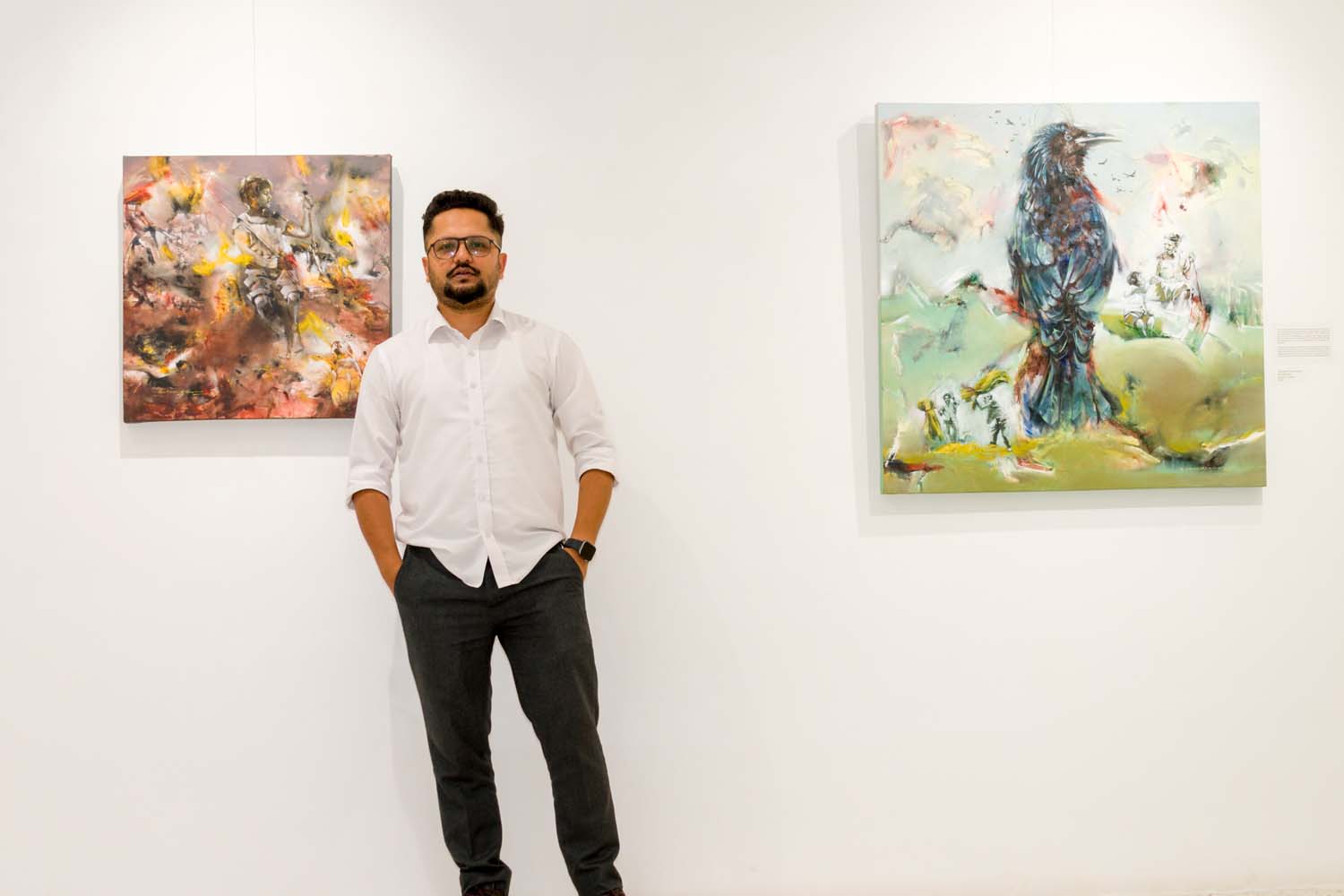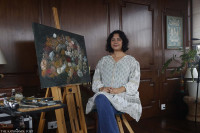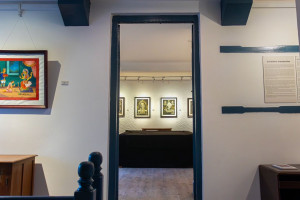Arts
Have we forgotten how to tell stories?
Drawing on tales from the mountains to the Tarai, artist Roshan Bhandari’s solo exhibition speaks to Nepal’s fading oral traditions.
Sanskriti Pokharel
When was the last time you heard a story from your parents or grandparents? Chances are, it was long ago. Perhaps in the bygone days of your childhood. This reflects a sad truth: the culture of oral storytelling is slowly fading, overshadowed by the rise of technology.
German-Jewish philosopher and cultural critic Walter Benjamin foresaw this shift as early as 1936, during the rise of mass media. In his famous essay ‘The Storyteller’ (1936), he wrote:
“The art of storytelling is coming to an end... It is as if something that seemed inalienable to us, the securest among our possessions, were taken from us: the ability to exchange experiences.”
Art can still bring us back to those lost traditions. Takpa Gallery’s recent solo exhibition ‘Once Upon a Time’ by Roshan Bhandari invites visitors to revisit a world where storytelling was woven into everyday life and humans and animals lived in harmony. The exhibition revives six folktales that are timeless, simple, and full of moral values.
“These are stories I’ve grown up with, from childhood to now,” Bhandari shares. “They’re easy for children to understand, but still rich in meaning.”
A closer look at Bhandari’s artworks reveals that they aren’t literal translations of the folktales they reference. Instead, they invite open interpretation. It’s clear that Bhandari intentionally creates space for viewers to engage with the work from their own perspectives.
The first piece that greeted me was ‘The Story of a Mountain–Contemplation’. And it was nothing short of captivating. What makes it so intriguing is its illusory nature. At first glance, you see a girl sitting in deep thought, but lingering a little longer, the outline of a bird subtly emerges from the same composition. It’s a visual puzzle that unfolds with time and attention.
When asked about this layered imagery, Bhandari admitted, “I didn’t plan it that way. I wasn’t thinking I would paint it like this. I was guided by my subconscious. I wanted to tell the story of a mountain girl, and I let the brush follow that narrative.”
Set in the Himalayan region, the painting reflects the rugged terrain and the resilience of life there. The rocky, earthy tones echo the topography and struggle of mountain living.
Interestingly, the eagle in the top left corner of the girl’s head wasn’t deliberate. Bhandari noticed it only after finishing the work. But like many great accidents in art, it adds a powerful layer of meaning.
Another painting, ‘Whispers of Nature: Misjudged Yet Miraculous’, tells the story of a woman from Nepal’s Tarai region. One of the most striking elements of the artwork is its use of golden colour. It symbolises the Tarai’s identity as the “granary of Nepal,” where vast paddy fields shimmer in the sun. The golden hues metaphorically represent abundance, sustenance, and the richness of the land.
In the painting, birds and animals gather around the woman, a visual cue to her connection with nature. According to the artist, she possesses a rare gift: the ability to communicate with animals. Touched by her kindness, a crow and a jackal led her to hidden treasures. Instead of keeping the riches for herself, she selflessly shares them with her in-laws. But instead of gratitude, she’s met with fear and suspicion. She is cast out of the family, branded a witch.
Her husband remarries, but misfortune follows. The new daughter-in-law brings cruelty, and the family’s wealth fades, drained by greed and laziness. Only then do the in-laws realise the painful truth: the woman they had rejected was not a curse, but a blessing in disguise.
Hence, the moral of the story is that love, trust, and unity are the true treasures that sustain a family through life’s many storms.

Bhandari’s strong belief in the importance of folktales is what inspired him to explore this theme through his art. This approach of telling stories through painting is a new artistic direction for Bhandari. His earlier works focused on themes like mental health and everyday conversations, especially the kind of conversations young people have in tea shops.
“Now, I’m turning to what was given to me in my childhood, what I heard, saw, and felt,” he explains. “Through this new work, I’m giving those memories back to the community. We often forget that storytelling is part of our culture. It deserves to be preserved and documented. That’s what inspired me. I believe my paintings can serve as a kind of archive.”
This exhibition marks the first edition of his storytelling series.
“I want to keep working on this theme,” he says. “I have so many stories to share. I grew up listening to my grandparents’ tales. They didn’t just entertain me, they sparked my imagination and helped me think critically. These stories shaped the way I saw the world.”
But today, Bhandari feels, storytelling is slipping away, replaced by digital forms of entertainment and fragmented attention.
“The storytelling culture is fading, and that saddens me,” he says.
Storytelling should be part of our everyday lives. It nurtures creativity, encourages contemplation, and builds empathy. It connects us not just to each other but to who we are.
Another painting, ‘The Silent Genius: Rising Beyond Shadows’, tells the story of a boy with three older brothers. While the elder siblings were proud and selfish, the youngest, portrayed in the artwork, is quiet, clever, and kind. After their father’s death, the older brothers claimed all the land and gold, leaving the youngest with only an old cow. Yet, he didn’t complain. He cared for the cow, sold its milk, and carefully saved every coin.
With time, he bought a horse to help carry goods across villages. That horse became his companion through every challenge. Together, they built a modest fortune through perseverance and honesty.
As his success grew, so did his brothers’ jealousy. They tried to cheat and undermine him, but he outwitted them each time. Eventually, the youngest brother became the most respected man in the region, not because of inherited wealth, but because of his intelligence, hard work, and integrity. His elder brothers, left with regret, finally understood: true wealth comes not from what you’re given, but from what you build with your mind and heart.
The moral of the story is clear: true strength lies in knowledge and character, not in inheritance.
In another painting, ‘Feathers of Fire and Envy,’ a bird takes centre stage while the human figures are rendered small and distant. The composition flips the usual perspective, turning the bird into the main character. It’s a powerful reminder of coexistence and how animals, too, play meaningful roles in the world’s stories.
Most of the works in the exhibition were painted between 2024 and 2025, and Bhandari spent about a year and a half completing them.
“Every piece was both easy and difficult in its own way,” he shares.
The exhibition has captured the hearts of children. Students from various schools have visited and connected with the stories. The simplicity of the folktales makes it easy for young minds to grasp, while the lack of literal illustration allows room for imagination. Viewers are seeing a painting, experiencing a story, reflecting on its meaning, and forming their own interpretations.

‘Once Upon a Time’
Where: Takpa Gallery, Lazimpat
When: May 25 to June 21
Time: Friday to Sunday: 11 am to 7 pm, Tuesday to Thursday: 11 am to 6 pm, closed on Mondays
Entry: Free




 13.12°C Kathmandu
13.12°C Kathmandu

%20(1).jpg&w=200&height=120)




%20(1).jpg&w=300&height=200)





